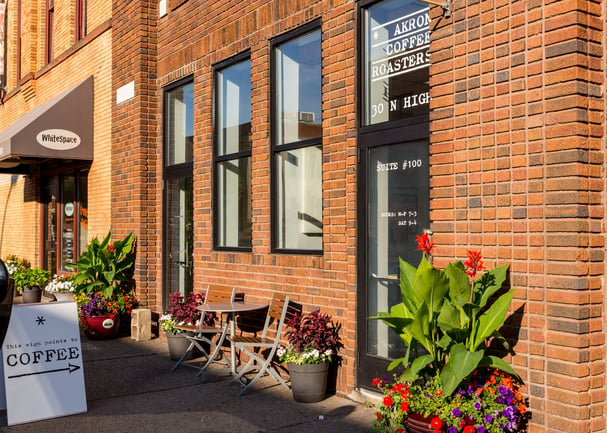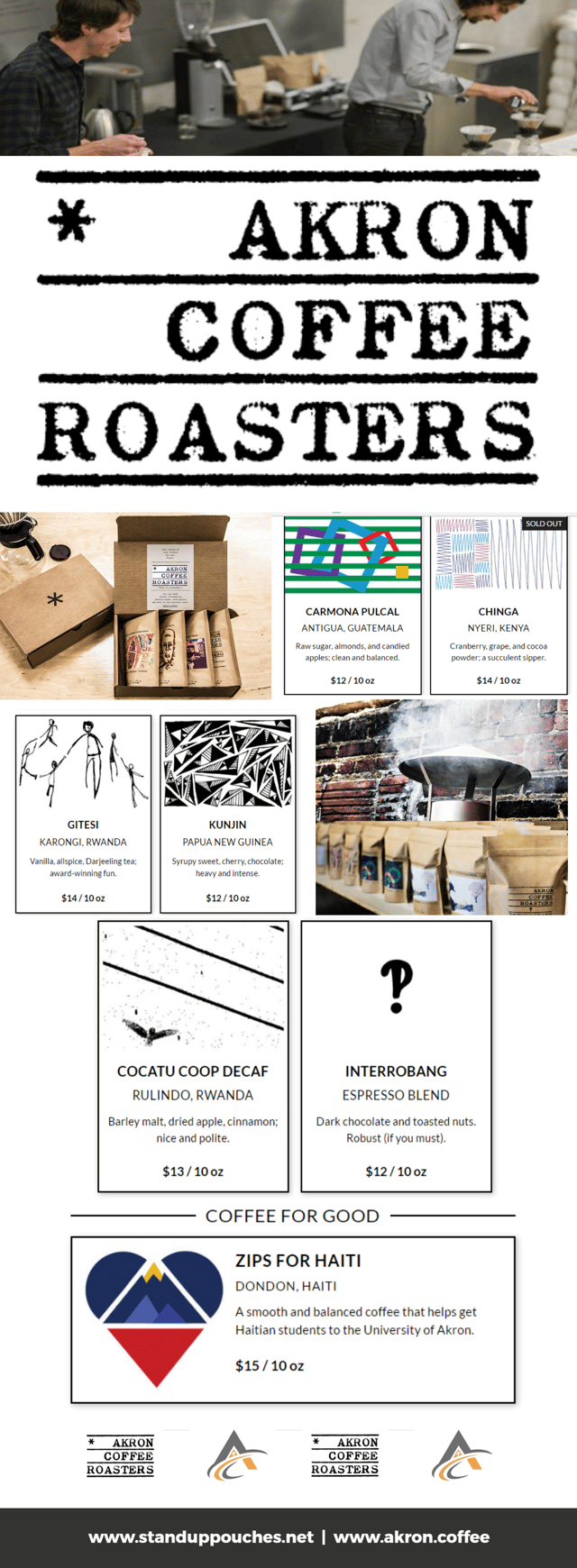
In the heart of downtown Akron, Ohio, sits a hidden gem for any coffee aficionado.
The warm aroma of earthy roasts fills the small space as customers sit quietly with their laptops, notebooks, or hot cups of their favorite beverage. Time and care are put into each cup of coffee in this building, setting it apart from the generic, fast-food beverages that come in disposable Styrofoam cups and cardboard drink carriers. The beauty of places like Akron Coffee Roasters is that the senses are immediately filled with the delightful taste, scent, and warmth of the product, inspiring drinkers to want to purchase a bag to take home so they can recreate the coffee-drinking experience in the comfort of their own kitchens.
Akron Coffee Roasters represents the “third wave” of coffee, which can be compared to the changes we’re seeing in the beer and wine industries. There is an emphasis on craft and detail when brewing up these beverages, which can sometimes mean they are released in limited quantities. The type of beans Akron Coffee roasts are sourced from around the world, a fact that is easily transparent right on the outside of their coffee packaging. Each coffee is named after the farm, mill, or region it’s sourced from — there are no “fancy” names or clever marketing techniques, just the facts about the coffee and the roasters’ thoughts on it. Using their coffee packaging to quietly but clearly explain where the beans came from appeals to consumers who want to know exactly what they’re purchasing so they can make an informed decision.
Albert Macso and Timothy Hollister founded Akron Coffee Roasters after realizing they could fill a need in their hometown for specialty, high-quality coffee. Macso says he grew up in Akron and moved to Portland to work in the accounting field, and it was there that he became immersed in the city’s vibrant coffee community.
“There were roasters on every block,” Macso says. “There’s a big coffee scene in Portland.”
Upon returning to Akron, he noticed the local shops weren’t selling the types of coffee roasts he was used to on the West Coast. Specifically, in the downtown area, there were plenty of offices and spaces for professionals to hold business meetings, but there were no active coffee shops. He started roasting his own beans as a personal hobby, then the small-scale operation became a full-fledged business with a storefront in the busy downtown Akron area.
Akron Coffee rotates its products seasonally based on harvest schedules, which means most of the roasts are limited edition. This fact makes each bag of roasted coffee special and sometimes rare. Because the owners focus on the fine details of each and every roast, their stand up pouches for coffee beans must reflect the unique qualities of the beans inside, something the roasters deliberately consider when designing the artwork for their bags for roasted coffee. Akron’s downtown has a vibrant historical art scene, and Akron Coffee Roasters' storefront sits within walking distance of the Akron Art Museum, Summit Artspace and several galleries in between. The artwork used for the outside of the coffee brand’s stand up pouches for coffee beans is both a reflection of the owners’ Akron roots and place in the community, as well as complementary to the origins of the beans themselves.
Macso and Hollister chose stand up pouches for coffee beans as their preferred coffee packaging to set their products apart from other coffee in the area and beyond. They chose not to use traditional coffee bags with tin ties for two reasons: They aren’t just another Starbucks copy or massive store brand, and making sure the coffee stays fresh is highly important for retaining its nuanced flavor notes. Macso selected stand up pouches with a kraft exterior because he thought the brown finish was visually appealing and worked well with the company’s minimalist style and branding.
Most importantly, he liked that the pouches contained a zip lock and were resealable to lock in freshness, as whole coffee beans remain fresh for only about two weeks. The coffee can still be consumed after that time, but it might lose some of the flavor notes Macso works so hard to bring forward in his roasts. He sells his coffee in whole bean form, rather than ground, because ground coffee actually stales much more quickly. He suggests grinding his whole bean coffee only when it’s ready to be brewed, as this will improve the taste greatly. The recommended storage for whole coffee beans is in an airtight container placed in a cool, dry space. Zipper stand up pouches make the perfect packaging solution, as they let air out, have an opaque finish, and fit nicely in cupboards.
Macso also says the stand up pouches for coffee he ordered for his roasts help keep his branding consistent and recognizable. He uses 10 oz. bags to sell his beans at the retail level and 2-lb. or 5-lb. bags for wholesale. Keeping a consistent image is important to Macso, and each bag provides plenty of “retail space” for custom labels, which include artwork by Hollister, who has a background in graphic design, as well as designs by local artists who live and work in Akron.
Akron Coffee Roasters is preparing to celebrate the one-year anniversary of its storefront with a special, limited-release roast with new artwork designs. Macso says in the future, they’d like to branch out beyond downtown Akron, although they currently sell their coffee at other local retail locations and provide a mail-order subscription service so customers never run out of their high-quality roasts. This is another example of how lightweight bags for roasted coffee are the perfect packaging solution, as they keep shipping costs down and eliminate the need for excessive, extraneous packaging to protect the beans during transportation.
Macso’s company prides itself on delivering an experience that is “equal parts art and science.” The artwork is on the bags for roasted coffee, and the science is in the roasting process and complex flavors. Through partnerships with other organizations in the Akron area, the coffee roasters have delivered special inspired coffee flavors to their local community, establishing themselves as the premier third-wave, single-origin coffee company their city needs.

(Image Source: Tim Fitzwater, Fitzwater Photography)







